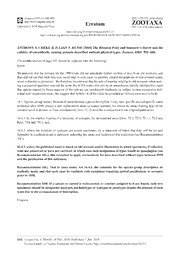
Erratum: ANTHONY S. CHEKE & JULIAN P. HUME (2018) The Réunion Fody and Sonnerat’s Shrew and the validity of scientifically naming animals described without physical types. Zootaxa, 4382: 592–600. PDF
Preview Erratum: ANTHONY S. CHEKE & JULIAN P. HUME (2018) The Réunion Fody and Sonnerat’s Shrew and the validity of scientifically naming animals described without physical types. Zootaxa, 4382: 592–600.
Zootaxa 4429 (3): 600–600 ISSN 1175-5326 (print edition) ZOOTAXA http://www.mapress.com/j/zt/ Erratum Copyright © 2018 Magnolia Press ISSN 1175-5334 (online edition) https://doi.org/10.11646/zootaxa.4429.3.13 http://zoobank.org/urn:lsid:zoobank.org:pub:89E9E398-26C8-44CB-92D5-96D0FC051F36 ANTHONY S. CHEKE & JULIAN P. HUME (2018) The Réunion Fody and Sonnerat’s Shrew and the validity of scientifically naming animals described without physical types. Zootaxa, 4382: 592–600. The middle section of page 597 should be replaced with the following: Quote We presume that the revisers for the 1999 Code did not anticipate further naming of taxa from old accounts, and thus did not see that their new rule could lead in such cases to patently absurd designations of non-existent types, never collected or preserved. We therefore recommend that for acts of naming relating to old accounts when mak- ing a preserved specimen was not the norm, the ICZN waive this rule by an amendment, ideally retrospective, such that species named by those unaware of the rule are not invalidated wholesale, or subject to time-consuming indi- vidual rule-suspension cases. We suggest that Article 16 of the Code be amended as follows (new text in bold): 16.4. Species-group names: fixation of name-bearing types to be explicit. Every new specific and subspecific name published after 1999, except a new replacement name (a nomen novum), for which the name-bearing type of the nominal taxon it denotes is fixed automatically [Art. 72.7], must be accompanied in the original publication 16.4.1. by the explicit fixation of a holotype, or syntypes, for the nominal taxon [Arts. 72.2, 72.3, 73.1.1, 73.2 and Recs. 73A and 73C], and, 16.4.2. where the holotype or syntypes are extant specimens, by a statement of intent that they will be (or are) deposited in a collection and a statement indicating the name and location of that collection (see Recommendation 16C). 16.4.3. unless the published name is based an old account and/or illustration in which specimens, if collected, were not preserved or have not survived, in which case such designation of types would be meaningless (see Recommendation 16G); this exception to apply retroactively for taxa described without types between 1999 and the publication of this subclause. Recommendation 16G. That in cases under Art 16.4.3. the rationale for the species-group description be explicitly made, and that such cases be confined, with exceptions requiring special justification, to accounts prior to 1850. Recommendation 16H. If a species so named is rediscovered or remains assigned to it are found, such new specimens should be designated neotypes, not holotypes or syntypes or paratypes despite the absence of such types due to the circumstances of description. Unquote 600 Accepted by A. Minelli: 26 Feb. 2018; Published: 7 Jun. 2018 Licensed under a Creative Commons Attribution License http://creativecommons.org/licenses/by/3.0
